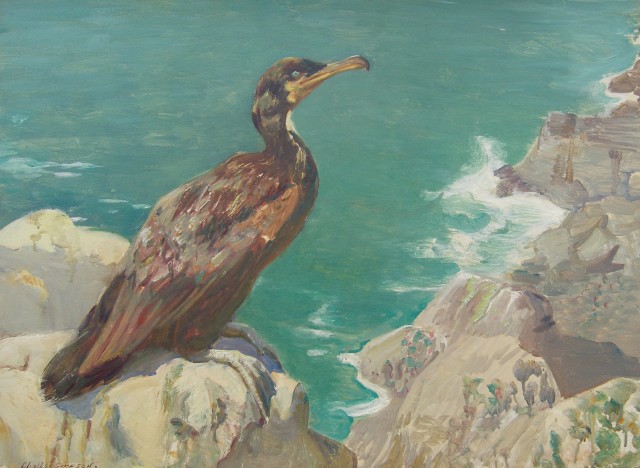Charles Walter Simpson
1885–1971
Charles Simpson was the son of Major General CR Simpson of the Lincolnshire Regiment and was destined for a career in the army, but this was prevented by a riding accident in his youth. Instead he turned to art, studying with Lucy Kemp-Welch at Bushey, J. Noble Barlow and Stanhope Forbes, RA, in Newlyn and in 1910 at Julien's atelier in Paris. Simpson had painted with Alfred Munnings in Norfolk in the early 1900's and may have persuaded Munnings to join the Newlyn colony in 1908. Munnings and Simpson remained lifelong friends. In 1913 Simpson married fellow artist Ruth Alison and moved to Newlyn, later residing in Lamorna and then London before settling permanently in Penzance. From 1916, with his wife, he ran a painting school in St. Ives. Simpson exhibited landscapes, bird and sporting paintings at the Royal Academy – 48 works in total from 1907 to 1953. Many of his hunting paintings were reproduced in Country Life. In 1924 he made sketches at the rodeo held at Wembley, from which he produced a book, El Rodeo. He won a gold medal at San Francisco in 1914, a silver medal at the Paris Salon in 1923 and a gold medal in the exhibition of sporting paintings produced in connection with the 1924 Paris Olympics. He became a member of the Royal Institute of Painters in Watercolours in 1914 and a member of the Royal Institute of Oil Painters in 1921. He worked in oil, watercolour and tempera.
Between 1910 and 1920 Simpson set to work on the remarkable Wild Bird Series which includes some eighty paintings in both oil and gouache on card. Simpson’s wish was to create a book of them, which was perhaps to include a series of zoo paintings, however, he was unable to interest a publisher in the project. He continued to work on the series with an exhibition in mind. Instead of the typical ornithological images that tended be highly pictorial and neutral in setting, Simpson concentrated more on the bird in its natural habitat. “…There is no attempt to prettify; the seabirds are predatory, their beaks vicious, their eyes reflecting what Simpson called the mystery and terror of all wildlife. The most decorative are those with more than a single bird…these are birds in their natural surroundings rather than on them.” This series was shown in St Ives, at Plymouth and also at the Laing Art Gallery in Newcastle. Simpson produced a pamphlet, specifically to accompany the exhibitions, in which he wrote that all of the paintings were executed on the north-west coast of Cornwall during the spring migration. The pamphlet reveals the same detailed observation as the paintings themselves with the addition of information that could not be show in a picture for example sounds and specific characteristics of different species.// Charles Simpson moved to London in 1924 but returned to Cornwall in 1931, where he spent the rest of his life. An outstanding bird painter, he was also renowned for racing paintings and equestrian portraits. He wrote and illustrated a number of books, among them The Harboro Country, Leicestershire and Its Hunts, Trencher and Kennel and Animals and Bird Painting: The Outlook and Technique of the Artist.
He is represented in a large number of public collections including the Victoria and Albert Museum and he became a member of the St Ives Society of Artists in 1943.
Museums:
Blackpool
The Grundy Art Gallery
Bournemouth
The Russell Cotes Art Gallery
The Derby Museum and Art Gallery
The Laing Art Gallery
Doncaster Art Gallery and Museum
The Royal Collection
Gateshead
The Shipley Art Gallery
Harrogate Art Gallery
The Royal Cornwall Museum
Newcastle Penlee House Gallery and Museum
Newport Art Gallery City Museum and Art Gallery
Nuneaton Art Gallery
The Mappin Art Gallery
Paisley Art Gallery
Penzance
Plymouth
Sheffield
Southshields Museum and Art Gallery
Sunderland Museum and Winter Gardens
Truro
Windsor
International Collections:
Perth
The Art Gallery of Western Australia
New Zealand Christchurch Art Gallery
Dunedin Art Gallery
